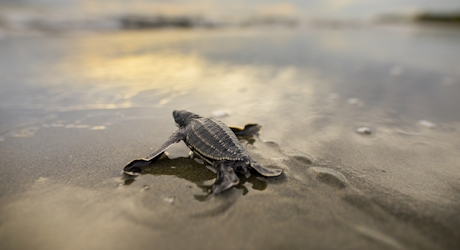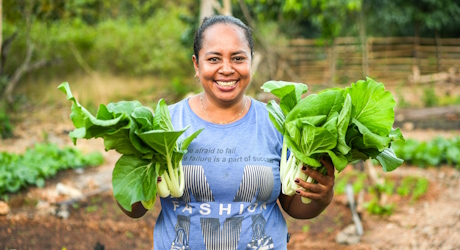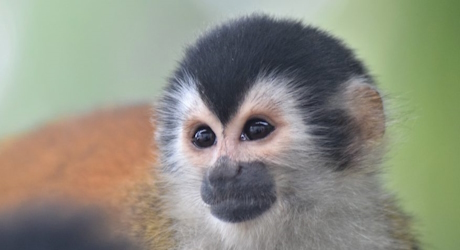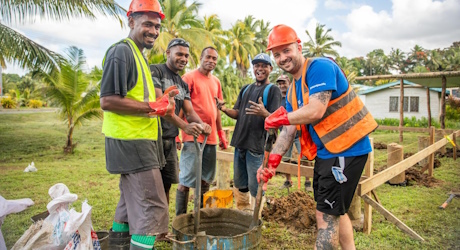Footprints Project
Since 2005, travelers like you have helped us change the world through micro-donations.
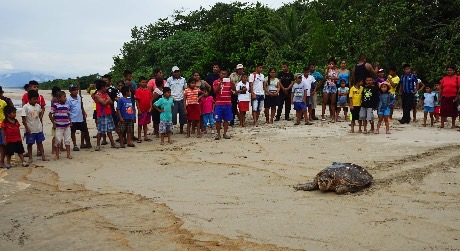
-
A total of
6792
Travelers
-
donated
$15006.75
(100% funded) -
to help improve
Environment
-
impacting
300
people -
in
Panama
Project background
Sea Turtle Conservancy (STC) has been working at several locations in the Bocas del Toro Province of Panama since 2003 to monitor and protect endangered sea turtle nesting populations. The region sees globally-important levels of nesting by critically-endangered hawksbill turtles and leatherback turtles. Nesting is concentrated at several relatively undeveloped beaches spread around the archipelago of Bocas del Toro.
Among these beaches is Playa Bluff – the only beach accessible by car or bike from the town of Bocas. This proximity makes turtles nesting here highly vulnerable to hunting by illegal poachers, many of whom are members of the indigenous community of Ngobe-Bugle Indians living along this coastline.
Since STC began its work in the region 15 years ago, nesting by both Hawksbills and Leatherbacks seas turtles has been increasing. This is very good news that bodes well for the future of these endangered turtle populations. One unforeseen problem is that illegal turtle hunters in the region also see the increasing numbers of turtles, and this has made the turtles easier for poachers to find and exploit.
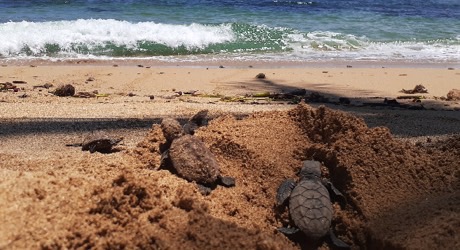
Project goals
This project was carried out during a 11-month period at Bluff Beach in the Bocas del Toro region of Panama. Financial support from the Footprints Network provided essential resources to carry out a program with the following primary goals:
- Select and teach indigenous community members in the proper techniques to take tourists on guided sea turtle nesting walks.
- Develop a model for ecotourism at Bluff Beach that employs local community members and directs funding to benefit the community.
- Promote sea turtle tourism in the town of Bocas del Toro to capitalize on the presence of tourists who visit the region to surf and explore the local environment.
- Train a select group of local community members how to track sea turtle nesting, mark nests and collect scientifically-accurate data to be shared with Sea Turtle Conservancy (STC) for long-term tracking of sea turtle health and abundance at Playa Bluff.
- Conduct community education activities to generate broad awareness about the threats facing sea turtles locally at Bluff Beach – and also about the value in protecting turtles rather than hunting them.
Project results
Goal 1:
During this reporting period, STC successfully selected and educated four indigenous community members in the proper techniques to take tourists on guided sea turtle nesting walks on Bluff Beach. STC staff provided specialized training to local community members to ensure that turtle walks were not disruptive to nesting turtles. Beach monitors were also trained in sea turtle biology, which gave them the opportunity to educate turtle walk attendees about the region’s leatherback and hawksbill turtles and provide a once-in-a-lifetime, hands-on experience for paying tourists.
Goal 2:
For decades, the province of Bocas del Toro was one of the most important sites for the turtle trade. Since STC began its work in the region 15 years ago, nesting by both hawksbills and leatherbacks has been increasing; this is very good news that bodes well for the future of these endangered turtle populations. A large component of STC’s work in Central America includes directly involving local community members with sea turtle conservation. By employing four local indigenous people to carry out STC’s research protocol and host turtle walks for tourists this season, STC invested in the local economy and inspired environmental stewardship among locals – demonstrating that Bluff Beach’s turtles are worth more alive.
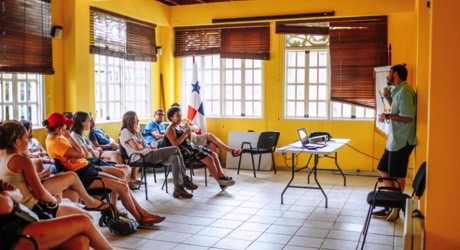
Goal 3:
While many tourists who visit Bocas del Toro take part in surfing, diving, snorkeling and boating during the day, nighttime activities are mostly limited to clubbing or bar-hopping. However, because Playa Bluff is the only beach accessible by car or bike from the town of Bocas del Toro, it serves as the perfect nighttime activity for tourists who are interested in safely witnessing sea turtle nesting activity. During this reporting period, STC’s office in the heart of the town served as a hub for tourists who were interested in learning more about the region’s turtles. A steady stream of tourists visited the center and paid for the opportunity to go on supervised turtle walks hosted by STC’s local beach monitors.
Goal 4:
Before nesting season began, STC recruited four local community members of the indigenous Ngobe-Bugle tribe to serve as beach monitors and carry out STC’s research protocol at Bluff Beach. Prospective beach monitors were required to participate in a three-day training workshop where they learned about sea turtle biology, conservation, threats and monitoring techniques. After the course, they were required to pass a written and practical exam before conducting sea turtle monitoring and research.
From March through April, beach monitors completed 57 surveys of the entirety of Bluff Beach, which consisted of recording the number of false crawls and nests as well as analyzing select nests to determine their fate. In total, beach monitors analyzed four hawksbill nests and nine leatherback nests; four of which were relocated due to the risk of inundation by high tides or potential poaching.
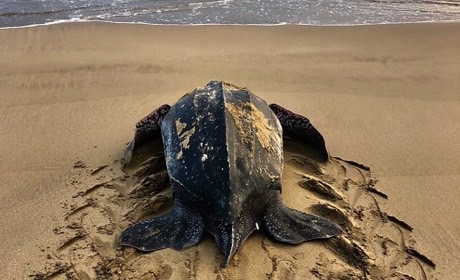
From 21 February through 30 April, beach monitors recorded 58 leatherback nests and four hawksbill nests on Bluff Beach. Of those, one hawksbill nest was poached and one leatherback nest was inundated by high tides. Staff also completed nightly patrols of the beach, which were carried out for five- to eight-hour periods, to flipper-tag and record biometric data on nesting turtles.
Goal 5:
STC continued to participate in its Environmental Education and Outreach Program in Bocas del Toro, which involves working with educational institutions, community members and leaders, and the tourism sector to inspire environmental stewardship of the region’s natural resources. During this reporting period, STC staff hosted events in the community to educate groups about sea turtle biology and their threats to survival. For example, assistant research coordinator Raul Garcia Varela educated students from Costa Rica’s Institute for Central American Development Studies about STC’s research programs.
In March, STC hosted a community-wide gathering to celebrate Bocas del Toro as a new “hope spot” in the world, a designation created by Mission Blue that recognizes places in the as critical to the health of the ocean. Raul also hosted a presentation for children from Carenero Island, a nearby remote community, to educate them about how to protect sea turtles. Through its community education efforts, STC inspired tourists and residents to care for and protect the region’s important sea turtle populations.

What next?
STC will continue to sustain and help to expand upon the work of local communities in Bocas del Toro to monitor and protect local sea turtle populations. The sea turtles in this region are under immense pressure from poaching and legal harvest, and STC intends to continue building conservation capacity in this region to ensure that its sea turtles survive well into the future.
Traveling soon? When you buy travel insurance with us, you can make a contribution towards a cause you care about.
Get a quote